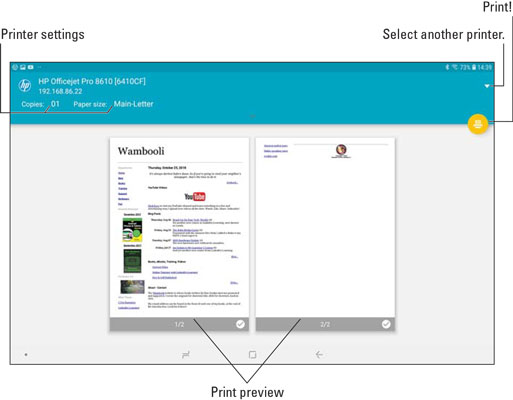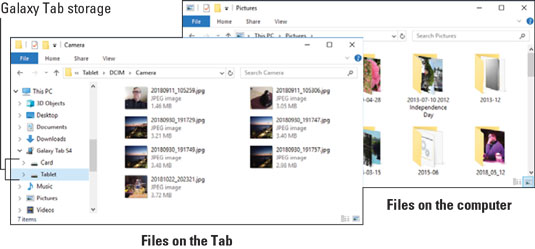How to Connect the Samsung Galaxy Tab to TV
It’s possible to view videos displayed or audio played on your Galaxy Tab S on an HDMI TV or monitor. As long as that TV or monitor has the Google Chromecast gizmo installed, screen sharing or casting is a snap. It’s how I watch movies from Play Movies & TV, Netflix, and Hulu Plus on the big screen.Here’s a general idea of how casting works:
- Ensure that both the Tab and the casting gizmo access the same Wi-Fi network.
- Open the app that has the media you want to play. For example, open HBO Now to watch Game of Thrones or Spotify to listen to tunes.
- Ensure that the HDTV or monitor is on and the input with the Chromecast dongle is selected. For example, on my Big, Expensive TV, Chromecast is on HDMI Input 1.
- Tap the Chromecast icon.
 If it doesn’t appear, redo Step 2.
When multiple Chromecasts exist on the same Wi-Fi network, choose one from the list.
If it doesn’t appear, redo Step 2.
When multiple Chromecasts exist on the same Wi-Fi network, choose one from the list. - Start playing the media. The item you select appears on the HDTV or monitor.
To stop casting, tap the Chromecast icon again and choose DISCONNECT, or you can just turn off the TV or monitor.
How to share files from the Galaxy Tab in the cloud
A wireless way to share files between a computer and the Galaxy Tab is to use one of several online storage apps, such as Google Drive or Dropbox. These apps grant your tablet access to Internet file storage, also known as cloud storage. Any other device that uses the online storage also has access to the files. That makes Dropbox an ideal way to share and swap files.The Tab comes with Google Drive. Dropbox is obtained, as well as other cloud storage apps, from the Play Store. Beyond installing those apps on your tablet, install their desktop counterparts on your computer or laptop. You get a modicum of free storage with your account, and you can pay to add more.
The files and folders accessed on cloud storage are available to both your computer and tablet. Copy, move, or create a file in one of the folders, and all your devices have access — provided an Internet connection is available.
- File management on the Galaxy tablet is handled by the My Files app, in case you're into that sort of thing. See the later section “Managing files.”
- You can configure the tablet so that pictures and videos you take are instantly uploaded to your Google Drive or to Dropbox.
How to print files from the Samsung Galaxy Tab
You may not think of it as “file sharing,” but using a printer with the Galaxy Tab is another way to get a file from here to there. It just happens that “there” is a printer, not a computer.Printing on your Galaxy Tab works like this:
- View the material you want to print. You can print a web page or photo or any number of items.
- Tap the Action Overflow icon and choose the Print action. If the Print action isn’t available, choose Share. On the list of sharing items, choose Print.
- Choose a printer from the Select Printer list or the action bar.
Any printer available on the Wi-Fi network that the Tab is using shows up in the list.
To view printers from the action bar, tap the bar, as illustrated.
- Change any print settings. For example, tap the Pages item to set the pages you want to print. Or change the number of copies. These are common print settings, similar to those you’d find in a computer’s Print dialog box.
- Tap the big ol’ Print button. The material you’re viewing spews forth from the printer.
 Choosing a printer.
Choosing a printer.Not every app supports printing. The only way to know is to work through Steps 1 and 2. If you don’t see the Print action, you can’t print.
If the printer service for your printer isn’t available, the Tab prompts you to download it. Proceed according to the directions presented on the screen.
How to transfer files by using the USB connection
The point of making the USB connection between your Galaxy Tab and a computer is to exchange files. You can't just wish the files over. Instead, I recommend following the advice in this section.A good understanding of basic file operations is necessary before you attempt file transfers between your computer and the Galaxy tablet. You need to know how to copy, move, rename, and delete files. It also helps to be familiar with what folders are and how they work. The good news is that you don't need to manually calculate a 64-bit cyclical redundancy check on the data, nor do you need to know what a parity bit is.
I can think of plenty of reasons why you would want to copy a file from your computer to the tablet. You can transfer pictures and videos, music, or audio files or copy vCards exported from the computer’s email program, which helps build the tablet's address book.Follow these steps to copy files between a computer and the tablet:
- Connect the Galaxy Tab to the computer.
- On a PC, if the AutoPlay dialog box appears, select the Open Folder/Device to View Files option. When the AutoPlay dialog box doesn't appear, press the Win+E keyboard shortcut to open a File Explorer window. Choose This PC from the navigation drawer and locate your Galaxy Tab’s storage icon(s) in that window. The tablet's folder window you see looks like any other folder in Windows. The difference is that the files and folders in that window are on the Galaxy Tab, not on the computer. On a Macintosh, the Android File Transfer program should start and appear on the screen.
- On the PC, open the folder that contains files you want to copy to the tablet, or into which you can to copy files from the tablet. Open the folder that contains the files, or somehow have the file icons visible on the screen.
- Drag file icons between the two folders. The figure illustrates two folder windows that are open on a PC: one on the Galaxy Tab and the other on the PC. Use the mouse to drag icons between the two folders. The same file dragging technique can be used for transferring files from a Macintosh. Drag the icons to or from the Android File Transfer window, which works just like any folder window in the Finder.
- Close the folder windows and disconnect the USB cable when you're done.
 Copying files to a Galaxy tablet.
Copying files to a Galaxy tablet.If you don’t know where to copy files to your Tab, I offer these recommendations:
- Copy music or audio files to the Music folder. Even then, a better way to copy music is to use a jukebox program on your computer to make the transfer.
- Copy images to the Pictures folder. As with music, a better option is to use a photo management program to transfer images to the tablet in an organized fashion.
- Copy all other files to the tablet’s Download folder. After all, you’re technically downloading files from the computer, so that seems like an obvious choice.





